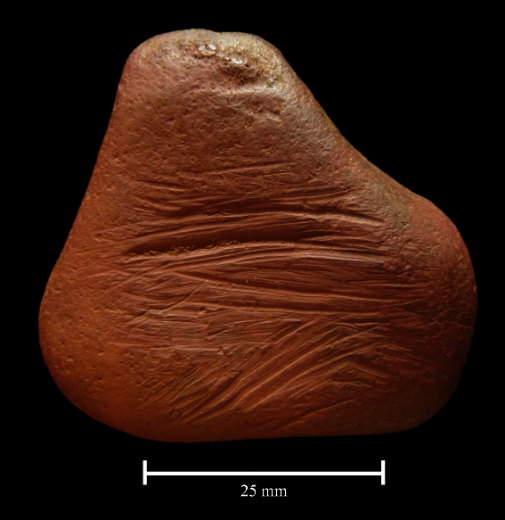One of the World’s Oldest “Crayons” Colors in Details of the Mesolithic World
An interdisciplinary team of archaeologists and physicists came together to discover the purpose of the ancient bit of sharpened red ochre
/https://tf-cmsv2-smithsonianmag-media.s3.amazonaws.com/filer/7a/a1/7aa14f79-c0c4-41d9-aad4-a5f11fec21bf/crayon_1.jpg)
The pieces of pigment were discovered on opposite sides of the ancient lake in North Yorkshire. One of the ancient chunks of red ochre— a type of reddish-brown clay used by prehistoric people around the world—is pebble-shaped. The other, viewed through a modern lens, resembles an ancient “crayon.”
Though the crayon-shaped piece was originally discovered in the 1980s and the pebble-shaped chunk was uncovered in 2008, as Janissa Delzo at Newsweek reports, only recently did researchers analyze them for the first time. Their findings appear in a new paper published in The Journal of Archaeological Sciences.
According to a press release, an interdisciplinary team of archaeologists and physicists at the University of York came together to examine the ochre using optical microscopy and Raman spectroscopy with micrometre spatial resolution to determine how the pigments were used.
They found both pieces of ochre have deep grooves, which suggests users scratched the clay to produce red-ochre powder. The researchers speculate that these pieces were likely used to produce art, an idea bolstered by the fact that a famous Mesolithic site near where the pigments were discovered, Star Carr, is known for the large number of artworks once produced there.
The crayon-shaped piece, specifically, is about three-fourths of an inch long and seems to be sharpened on one side. It also has wear patterns indicating that it was rubbed similar to a pencil or crayon.
“I was really amazed by how small and delicate the piece is. It is only a few centimeters long yet preserves very clear evidence of having been used by Mesolithic humans,” Andy Needham, archaeologist from the University of York and first author of the study, tells Delzo.
Stone Age people in Britain did not have one source for their ochre. Instead, it was collected in many different places and processed in different ways depending on its intended use. In the release, Needham explains that color was a "very significant part of hunter-gatherer life." He adds that the ochre pigment's bright red hue offers a unique window into the world of Stone Age Briton.
“For me [the crayon] is a very significant object and helps us build a bigger picture of what life was like in the area; it suggests it would have been a very colorful place," he says.

Stone Age Britons weren’t the only people who used red ochre. In fact, the dried red-clay powder is found in Stone Age sites around the world. Red ochre was even found on flint and bone fragments of Neanderthals uncovered in the Netherlands, suggesting that it has been used for artistic and ceremonial purposes for up to 200,000 years. It was also recently found on the 11,500-year-old remains of an infant baby girl unearthed in Alaska and is known from extensive use in Africa and Australia.
But though the pigment is best known as an art material, Tammy Hodgskiss at the Conversation says it had many other uses for early humans, making it one of their most important natural products. It was also used on the body as an insect repellant and as a sunscreen. Anti-bacterial properties in ochre made it a popular way to tan or preserve animal hides. Ochre powder was also an ingredient in making adhesives which used to mount stone tools on handles.